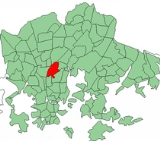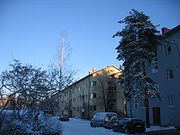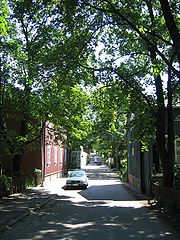
Käpylä
Encyclopedia

Helsinki
Helsinki is the capital and largest city in Finland. It is in the region of Uusimaa, located in southern Finland, on the shore of the Gulf of Finland, an arm of the Baltic Sea. The population of the city of Helsinki is , making it by far the most populous municipality in Finland. Helsinki is...
with 7,600 inhabitants. Administratively speaking, Käpylä is a part of the Vanhakaupunki
Vanhakaupunki
Vanhakaupunki is a neighbourhood of the city of Helsinki, Finland, to the north of Toukola. The district's name is because Helsinki was originally founded at the Vanhakaupunki area. Vanhakaupunki even appears in the new Helsinki foundation document from 1639, and the forms Gamla staden or...
district.
It is located between Kumpula
Kumpula
Kumpula is a verdant neighbourhood in Helsinki, bordered by Eastern Pasila to the west, Vallila to the south, Käpylä and Koskela to the north and Toukola and Arabianranta to the east. As of January 1, 2003, Kumpula had approximately 3,600 inhabitants....
, Oulunkylä
Oulunkylä
Oulunkylä is a suburb and a neighbourhood of Helsinki, the capital of Finland. It is located north from the center of the city.It has been inhabited since the 13th century. Earlier an independent municipality, it was made part of Helsinki in 1946. A rink used for speed skating and bandy is...
and Koskela. Käpylä has an end stop for the Helsinki tram
Helsinki tram
The Helsinki tram network forms part of the Helsinki public transport system organised by Helsinki Regional Transport Authority and operated by Helsinki City Transport in the Finnish capital city of Helsinki. The trams are the main means of transport in the city centre. 56.6 million trips were made...
network.
Additionally, the Olympic Village built for the 1952 Summer Olympics
1952 Summer Olympics
The 1952 Summer Olympics, officially known as the Games of the XV Olympiad, were an international multi-sport event held in Helsinki, Finland in 1952. Helsinki had been earlier given the 1940 Summer Olympics, which were cancelled due to World War II...
and another village for the cancelled 1940 Summer Olympics
1940 Summer Olympics
The anticipated 1940 Summer Olympics, officially known as the Games of the XII Olympiad and originally scheduled to be held from September 21 to October 6, 1940, in Tokyo, Japan, were cancelled due to the outbreak of World War II...
are located in Käpylä. The Park Hotel, located in Käpylä, became known for being the shooting location of the popular Finnish satirical TV series Hyvät herrat. The lyceum school situated in Käpylä has a specific orientation towards students with an interest in the natural sciences.
The tram lines 1 and 1A as well as the Tuusulanväylä freeway bus lines travel to Käpylä. The I- N- and T-trains of the Helsinki commuter rail
Helsinki commuter rail
Helsinki commuter rail is the commuter rail system serving Greater Helsinki, Finland. The network is operated by VR, the Finnish national railway company. Together with the Helsinki Metro and trams, the network forms the heart of Helsinki's public transportation infrastructure.Trains run above...
system stop at Käpylä railway station.
There are smaller regions inside Käpylä, Puu-Käpylä (wood-Käpylä) and Taivaskallio.
Puu-Käpylä

Garden city movement
The garden city movement is a method of urban planning that was initiated in 1898 by Sir Ebenezer Howard in the United Kingdom. Garden cities were intended to be planned, self-contained communities surrounded by "greenbelts" , containing proportionate areas of residences, industry and...
. The suburb of wooden buildings, designed by Martti Välikangas
Martti Välikangas
Martti Välikangas was a Finnish architect renowned for the design of so-called "Puu-Käpylä" [Wood-Käpylä], the Garden City housing area in Käpylä near Helsinki, designed in the Nordic Classicism style.Välikangas studied architecture at Helsinki University of Technology, qualifying as an architect...
, was built between 1920 to 1925 and designed in the so-called Nordic Classicism
Nordic Classicism
Nordic Classicism was a style of architecture that briefly blossomed in the Nordic countries between 1910 and 1930....
style prevalent throughout the Nordic countries at the time. Puu-Käpylä was a model workers’ housing area, built at a time when there was a bad housing problem for workers in the city. The construction follows the typical Finnish vernacular method: square-log construction then faced in weatherboarding. However, the whole process was partly industrialized, and the area is regarded as the first prefabricated housing area in Finland. The mostly 2-storey semi-detached timber houses are arranged around sheltered courtyards, where originally the tenants’ vegetable gardens were sited. The colours vary slightly from one house to another, but with a dominance of traditional red ochre. The area is still mostly occupied by working-class families though it has also been a popular residential area for professional types, especially architects – and it also has become a favourite tourist attraction.
Välikangas, together with architect Hilding Ekelund, also participated in the design of the Olympic Village situated in Käpylä.
Käpylä was incorporated into the city of Helsinki
Helsinki
Helsinki is the capital and largest city in Finland. It is in the region of Uusimaa, located in southern Finland, on the shore of the Gulf of Finland, an arm of the Baltic Sea. The population of the city of Helsinki is , making it by far the most populous municipality in Finland. Helsinki is...
in 1906.
Sports
Football club Käpylän PalloKäpylän Pallo
Käpylän Pallo or KäPa for short, is a football club from the Käpylä district of Helsinki. The club is currently playing in the Kakkonen, the third tier of the Finnish league system. KäPa play their home matches at the Max Westerberg Areena, situated in Käpylän liikuntapuisto...
plays in Kakkonen
Kakkonen
Kakkonen is the third tier of the Finnish football league system.-League structure:Kakkonen is divided to three groups of 14 clubs. A club plays each of the others in the same group twice, once at their home stadium and once at that of their opponents. Clubs gain three points for a win, one for a...
, the third tier of football in Finland. The city was part of the road cycling
Cycling at the 1952 Summer Olympics
The cycling competition at the 1952 Summer Olympics consisted of two road cycling events and four track cycling events, all for men only.-Medal summary:-Medal table:...
event for the 1952 Summer Olympics
1952 Summer Olympics
The 1952 Summer Olympics, officially known as the Games of the XV Olympiad, were an international multi-sport event held in Helsinki, Finland in 1952. Helsinki had been earlier given the 1940 Summer Olympics, which were cancelled due to World War II...
.

